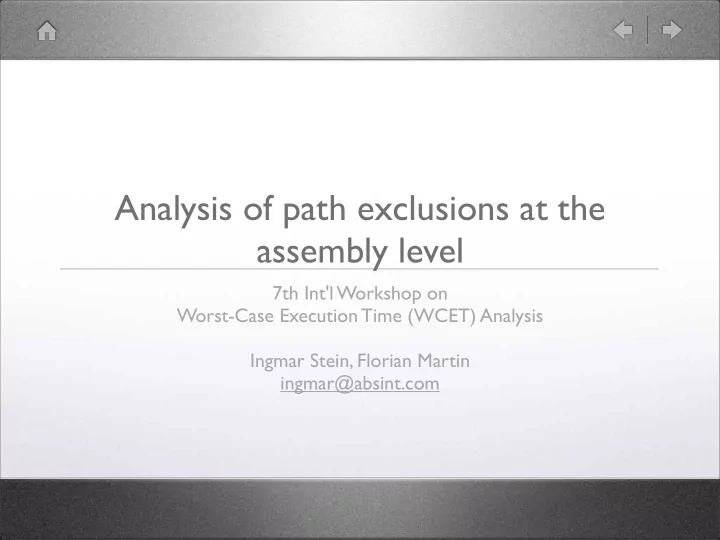

Analysis of path exclusions at the assembly level 7th Int'l Workshop on Worst-Case Execution Time (WCET) Analysis Ingmar Stein, Florian Martin ingmar@absint.com
The Goal A Jump conditions B C are equivalent 10 100 D E F 200 110 100 10 G
The Goal (2) • if (flag) do_something_expensive(); /* ... */ if (flag) do_something_cheap(); else do_something_expensive(); • Generated Code
Overview • Build expressions for jump conditions • trivial for high-level languages, but not for machine code • Compare those expressions using a solver library (Omega) • Use implications to generate new ILP constraints which exclude the infeasible paths
Analysis • Forwards analysis • Analyses all conditional jumps where the contents of the condition register are still unknown after the value analysis • Creates backward slices with the condition register as the initial target
Slices • Slice: set of program points which directly or indirectly influence the values at a given program point • Example: add r5, r3, r4 cmpi cr0, 0, r5, 0 bc 0xd, cr0, 0x2c.t
Linear Slices • A slice is called linear , iff the program points in the slice can be sorted, so that each program point is dominated by its predecessor A A B C B C D D non-linear linear
Slice trees bc add r5, r3, r4 0xd cmpi 0x2c.t cmpi cr0, 0, r5, 0 0 add 0 bc 0xd, cr0, 0x2c.t r3 r4 Constant Folding: (addi r5, 0, +16) ➟ 16
Slice trees (2) • Nodes: instructions • Leaves: registers, memory cells, immediates
Omega • “Framework and algorithms for the analysis and transformation of scientific programs” by William Pugh and the Omega Project Team • http://www.cs.umd.edu/projects/omega/ • Two Components • Omega-Test • Framework
Omega-Test • Presburger Arithmetic • First-order arithmetic over the natural numbers • ∀ , ∃ ,¬, ∧ , ∨ ,+,-,=, ≠ • No multiplication! • Decidable
Omega-Test (2) • Simplifies and decides Presburger formulas • Exponential runtime in the worst case • Experimentally known to be fast enough for small problems
Slices ➩ Omega • Instructions in the slice tree are mapped to arithmetic and comparison operators according to their semantics bc > 0xd cmpi 0x2c.t + 0 0 add 0 r3 r4 r3 r4 Slice Omega
Slices ➩ Omega (2) • Instructions with unknown semantics are treated as symbolic functions • mul r3, r4, r5 ➟ mul(r3, r4, r5) • Operator Strength Reduction helpful for multiplication
Slices ➩ Omega (3) • Leaves • Immediates become integer constants • Registers and memory cells become free variables
Slices ➩ Omega (4) • Given Omega trees for the basic blocks A and B • A ⇒ B? • A ⇒ ¬B? • ¬A ⇒ B?
Comparing Omega trees • Compare Omega trees of slices with a common start point • Stop slicing at the beginning of a function
Flow Constraints • Relative execution counts of basic blocks • Part of the ILP for the path analysis • As AIS annotation: FLOW EACH ProgramPoint 1 / ProgramPoint 2 IS MIN min MAX max
Flow-Constraints (2) • A ⇒ B: A.t / B.t ≦ 1 • A ⇒ ¬B: A A.t / B.f ≦ 1 A.f A.t • ¬A ⇒ B: A.f / B.t ≦ 1 B B.f B.t • ¬A ⇒ ¬B: A.f / B.f ≦ 1 • Symmetric
Implementation • Implementation of the algorithm for the PowerPC architecture • Additional architectures need their own mapping of the semantics • Uses the generic slicer by Marc Schlickling • Integrated into a special aiT version
Evaluation without flow with flow constraints constraints Synthetic 3054 cycles 2290 cycles example WBBC 2964 cycles 2961 cycles FCGU 1247 cycles 1221 cycles
Future Work • Other Architectures • Non-linear slices • Per-context flow constraints • Dead code elimination • Information about path exclusions can be used for other things besides flow constraints • May be beneficial to PAG-generated analyzers
Summary • A method to find path implications in the control flow graph • Application in the path analysis • Can improve the WCET prediction by eliminating infeasible paths • May be used to improve PAG analyzers
?
Recommend
More recommend